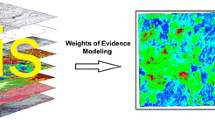Abstract
The weights of evidence modeling (WEM) for binary patterns is extended to take account of general categorical variables. The extension makes it possible to use the weights of evidence model in estimating the conditional probability distributions of metal grades. First, the target feature is converted into a set of binary target indicators. Second, the posterior probabilities are estimated for each of the target categories. Third, the estimates are combined to yield the posterior probability distribution of the target feature. Finally, the pseudometal estimates are derived from the probability distribution. The metal grade estimates are prefixed with “pseudo”, because the estimates are created from indirect evidence (explanatory variables). The pseudo-estimates provide a unique quantitative means to the delineation of exploration targets. This advantage reduces the ambiguities of target selection based solely on probability estimates. In order to use the generalized WEM, continuous geoscience attributes must be converted into categorical variables by means of optimal segmentation based on the target attribute of interest. The segmentation may be viewed as a process of defining evidence of the target feature. The extended weights of evidence model is demonstrated on a case study to select gold targets of Carlin type. The dataset used in the modeling includes apparent resistivity fields, soil geochemical samples, lithological and alteration information, and structural data.
Similar content being viewed by others
References
Agterberg, F. P., 1974, Automatic contouring of geological maps to detect target areas for mineral exploration: Mathematical Geology, v. 6, no. 4, p. 373–395.
Agterberg, F.P., 1989, LOGDIA-FORTRAN 77 program for logistic regression with diagnostics. Computers & Geosciences, v. 15, no. 4, p. 599–614.
Agterberg, F. P., 1992, Combining indicator patterns in weights of evidence modeling for resource evaluation: Nonrenewable Resources, v. 1, no. 1, p. 39–50.
Agterberg, F. P., and Bonham-Carter, G. F., 1990, Deriving weights of evidence from geoscience contour maps for the prediction of discrete events,in Proceedings 22nd APCOM Symposium, Berlin, September 1990: Technical University, Berlin, v. 2, p. 381–396.
Agterberg, F. P., Bonham-Carter, G. F., Cheng, Q., and Wright, D. F., 1993, Weights of evidence modeling and weighted logistic regression for mineral potential mapping,in Davis, J. C., and Herzfield, U. C., eds., Computers in geology—25 years of progress: Oxford University Press, p. 13–32.
Agterberg, F. P., Bonham-Carter, G. F., and Wright, D. F., 1990, Statistical pattern integration for mineral exploration,in Gaal, G., and Merriam, D. F., eds., Computer applications in resource exploration: Oxford, Pergamon Press, p. 1–15.
Bishop, M. M., Fienberg, S. E., and Holland, P. W., 1975, Discrete multivariate analysis: theory and practice: Cambridge, MA, MIT Press, 587 p.
Bonham-Carter, G. F., Agterberg, F. P., and Wright, D. F., 1988, Integration of geological datasets for gold exploration in Nova Scotia: Photogrammetry and Remote Sensing, v. 54, no. 11, p. 1585–1592.
Bonham-Carter, G. F., and Agterberg, F. P., 1990. Applications of microcomputer-based geographic information system to mineral-potential mapping,in Hanley, J. T., and Merriam, D. F., eds., Microcomputer applications in geology II. Oxford, Pergamon Press, p. 49–74.
Chung, C. F., 1978, Computer program for the logistic model to estimate the probability of occurrence of discrete events: Geological Survey of Canada, Paper 78-11, 23p.
Pan, G. C., 1992, Regionalized favorability theory for information synthesis in mineral exploration: Mathematical Geology, v. 25, p. 603–631.
Pan, G. C., 1993a, Canonical favorability model for data integration and mineral potential mapping: Computers & Geosciences, v. 19, no. 8, p. 1077–1100.
Pan, G. C., 1993b, Indicator favorability theory for mineral potential mapping: Nonrenewable Resources, v. 2, no. 4, p. 292–311.
Pan, G. C., and Harris, D. P., 1990, Three nonparametric techniques for optimal discretization of quantitative geological measurements: Mathematical Geology, v. 22, p. 220–232.
Pan, G. C., and Harris, D. P., 1991, A new multidimensional scaling technique based upon associations among triple variable—P ijk and its applications to the analysis of geochemical data. Mathematical Geology, v. 23, p. 861–886.
Pan, G. C., and Harris, D. P., 1992a. Estimating a favorability function for the integration of geodata and selection of mineral exploration targets: Mathematical Geology, v. 24, p. 177–202.
Pan, G. C., and Harris, D. P., 1992b, Decomposed and weighted characteristic analysis for the quantitative estimation of mineral resources: Mathematical Geology, v. 24, p. 177–202.
Pan, G. C., and Harris, D. P., 1992c, The related information approach to the integration of diverse geological data and mineral resources estimation,in Kim, Y. C., ed., Proc. of 23rd APCOM Symposium: Tucson, Arizona, April 7–11, p. 969–979.
Pan, G. C., and Xia, L., 1993, Optimal reduction of multiple data structures by theP ijk -type model: Computers & Geosciences, v. 19, no. 3, p. 355–389.
Author information
Authors and Affiliations
Rights and permissions
About this article
Cite this article
Pan, G. Extended weights of evidence modeling for the pseudo-estimation of metal grades. Nat Resour Res 5, 53–76 (1996). https://doi.org/10.1007/BF02259070
Received:
Accepted:
Issue Date:
DOI: https://doi.org/10.1007/BF02259070




